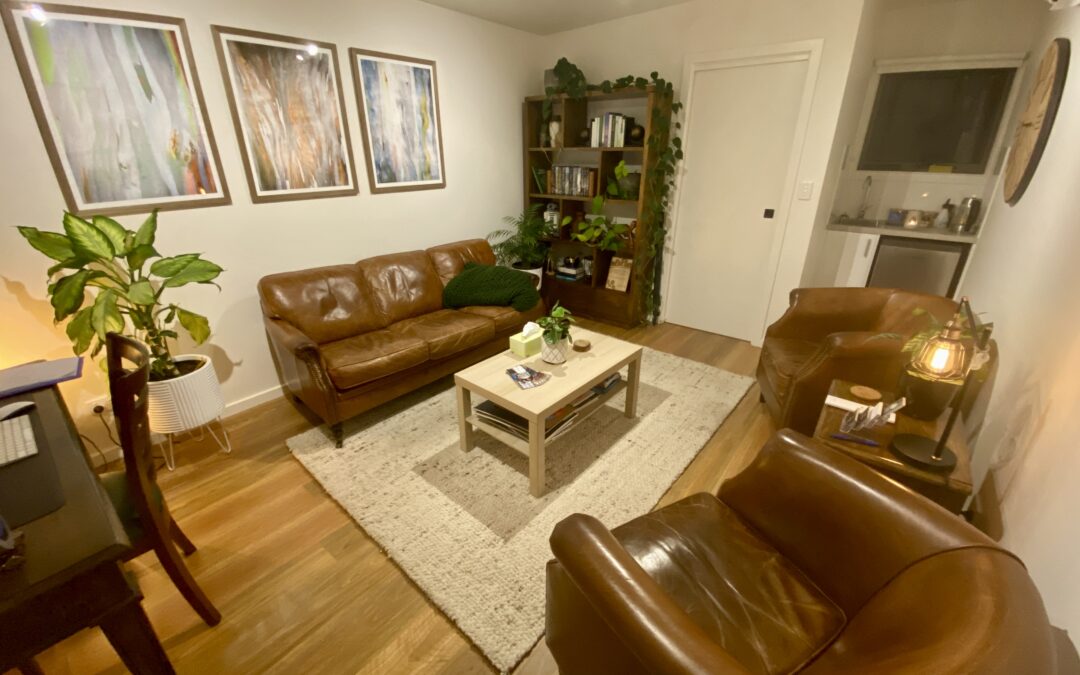Peace and calm are important to the highly sensitive person.
So when time, resources and location allows, there are a few things we can do to set up our homes and living spaces to promotes peacefulness and give our central nervous system the opportunity to rest.
The photo above is taken of my counselling room at night, just after my last client for the today left. I don’t want to claim this is the perfect example, but it gives you a visual for the space where I have been experimenting with calm. I want my therapy space to be a place of peace for my clients, especially when we are dealing with grief and trauma.
Much of what I talk about in this article is based on the studies summarised by Kathy Wallis in her book “Good Nature: The Science of How Nature Improves Our Health”. She’s the Professor of Biodiversity at the University of Oxford, meaning she knows her stuff!
In short, our senses take in information from the environment around us and our brain then interprets that information as something that is calming or not. Not surprisingly, the natural environment is a trigger for calm.
In our homes and office spaces, it is important to include as much of the natural environment as we can to promote calmness. Basically, we need to bring the out side, inside.
Here are some suggestions on how to set up where you live or work to appeal to your high sensitivity
Sight
- Try and set up a view of nature from the windows in your bedrooms, living room and workspaces. As much as we would all love a view of the mountains, some strategically placed pots or a nicely maintained garden area will still produce a deeper sense of calm than bricks and concrete.
- When hanging pictures on the wall of photos on the shelf, be sure to include pictures where your loved ones are in a natural environment. Seeing people we love and nature together brings a smile.
- Indoor plants can be a bit temperamental at times (I have a palliative ward for some of mine) but having a number of plants can help keep the air in your space clean, and bring a sense of calm to rooms.
Smell
- Indoor plants were mentioned about, but choosing plants based on their aroma, not just on their visual appeal is important.
- Cut flowers can symbolise love or gratitude, but their smell can bring calm.
- Research indicates that our brains associate some smells with emotions. The smells of nature can be associated with relaxation, holidays and fun. In my counselling room I often have a mix of eucalyptus and lemon in the burner that my clients often say makes the space more peaceful and inviting.
Sound
- Calming music is a bit of a no brainer here. Have it on in the back ground, loud enough to hear but not loud enough to dominate.
- If you can’t open a window and hear the sounds of water running or birds singing, play some nature soundtracks. Even recordings of nature bring calm.
- If you have the resources, consider good insulation and double glazed windows to keep the unpleasant sounds out
Touch
- When we touch wood and natural fibres our brains respond again with calm. Try and avoid plastic and metals if you can.
For the highly sensitive person, home is the sanctuary. To maintain our energy levels and to allow ourselves to decompress from the stimulation of the day, being able to walk into a place of peace is vital.
Likewise, if we can set up our work spaces to avoid the over stimulation in the first place, we won’t be so frazzled at the end of the day.
If you have any suggestions that have worked for you about making home a sanctuary, please share them in the comments below.
– Matt

